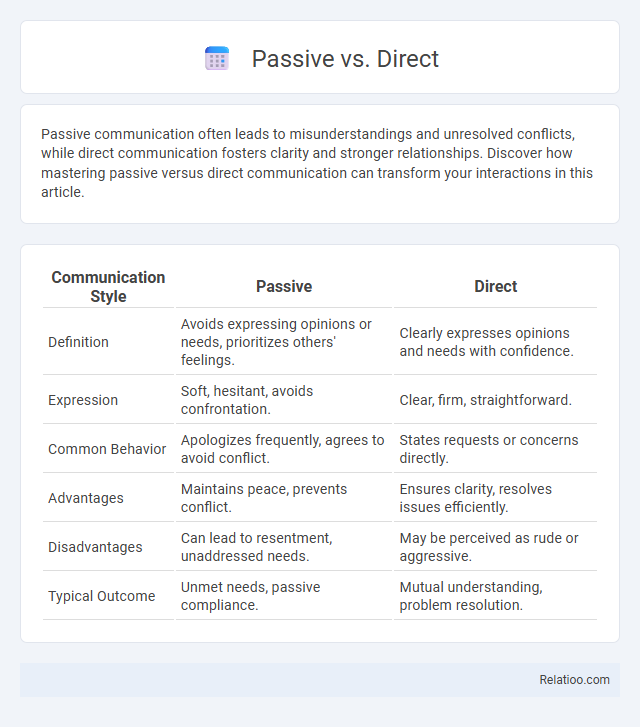Passive communication often leads to misunderstandings and unresolved conflicts, while direct communication fosters clarity and stronger relationships. Discover how mastering passive versus direct communication can transform your interactions in this article.
Table of Comparison
| Communication Style | Passive | Direct |
|---|---|---|
| Definition | Avoids expressing opinions or needs, prioritizes others' feelings. | Clearly expresses opinions and needs with confidence. |
| Expression | Soft, hesitant, avoids confrontation. | Clear, firm, straightforward. |
| Common Behavior | Apologizes frequently, agrees to avoid conflict. | States requests or concerns directly. |
| Advantages | Maintains peace, prevents conflict. | Ensures clarity, resolves issues efficiently. |
| Disadvantages | Can lead to resentment, unaddressed needs. | May be perceived as rude or aggressive. |
| Typical Outcome | Unmet needs, passive compliance. | Mutual understanding, problem resolution. |
Introduction to Passive vs Direct Approaches
Passive and direct approaches differ primarily in their engagement and execution style; passive methods rely on observation and indirect influence, while direct approaches involve active intervention and immediate feedback. In communication and learning contexts, passive approaches emphasize receiving information without immediate response, whereas direct approaches foster interactive participation and real-time adjustments. Understanding these distinctions is crucial for selecting strategies in education, marketing, and negotiation to optimize outcomes based on situational demands and goals.
Defining Passive Methods
Passive methods involve receiving information or stimuli without active engagement, often relying on observation or absorption, such as listening to lectures or watching videos. In contrast, direct methods require active participation, like hands-on experiments or interactive discussions that promote deeper learning through immediate feedback and application. Understanding passive methods is essential for identifying learning scenarios where minimal intervention or physical effort is sufficient, emphasizing receptive skills and situational awareness.
Understanding Direct Strategies
Direct strategies involve actively engaging with information through actions like note-taking, summarizing, or teaching concepts to others, thereby enhancing comprehension and retention. This method contrasts passive strategies, where learners merely receive information without interaction, leading to lower retention rates. Emphasizing direct strategies supports deeper cognitive processing, improving memory consolidation and application in real-world contexts.
Key Differences Between Passive and Direct
Passive voice emphasizes the action or the recipient of the action, often omitting the subject performing it, while direct voice clearly identifies the subject performing the action, resulting in more concise and impactful sentences. Your choice between passive and direct voice affects clarity and engagement, with direct voice typically preferred in business communication for its straightforwardness and assertiveness. Passive structures can be useful for formal or scientific writing where the focus is on the action or result rather than the actor.
Advantages of Passive Approaches
Passive approaches offer significant advantages such as minimal energy consumption, reduced system complexity, and enhanced durability due to fewer moving parts. These methods improve reliability and lower maintenance costs by relying on natural forces like gravity or thermal gradients instead of external power sources. The sustainability and cost-effectiveness of passive techniques make them ideal for long-term applications in building insulation, solar heating, and water treatment systems.
Benefits of Direct Methods
Direct methods in data collection and analysis offer enhanced accuracy by capturing real-time, unmediated information, reducing the risk of errors inherent in passive data gathering. These approaches enable immediate feedback and more precise measurement of targeted variables, improving the quality of insights derived. Businesses leveraging direct methods benefit from increased control over data integrity and quicker adaptation to changing conditions.
Choosing the Right Approach: Factors to Consider
Choosing the right approach between Passive, Direct, and Passive voice depends on clarity, tone, and emphasis in communication. Direct voice emphasizes the subject performing the action, making sentences clear and concise, while Passive voice highlights the action or recipient, useful in formal or objective contexts. Consider the audience, purpose, and desired impact to select the approach that enhances understanding and maintains engagement.
Common Applications of Passive vs Direct
Passive components like resistors and capacitors are commonly used in filtering, signal attenuation, and impedance matching, essential for analog circuit design. Direct components, such as direct injectors and direct connections, are prevalent in power delivery systems and audio equipment to minimize signal loss and maintain high fidelity. Comparatively, passive systems offer reliability and simplicity in signal processing, while direct systems emphasize efficiency and precision in power or signal transmission.
Challenges and Limitations
Passive systems often struggle with limited responsiveness and reduced efficiency in dynamic environments due to their reliance on external stimuli. Direct systems face challenges in complexity and cost, as they require precise control mechanisms and robust sensors for effective operation. Combining passive and direct approaches can mitigate some limitations but introduces integration difficulties and increased design complexity, affecting overall system reliability.
Conclusion: Which Approach Wins?
Direct communication often proves most effective in achieving clarity and prompt results, while passive approaches can create ambiguity and delay decision-making. Passive-aggressive methods tend to undermine trust and foster misunderstandings, ultimately hindering collaboration. Your best choice depends on context, but prioritizing directness typically wins for clear, efficient interactions.

Infographic: Passive vs Direct
 relatioo.com
relatioo.com